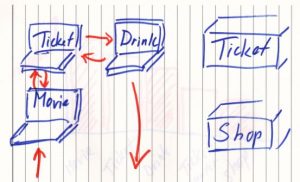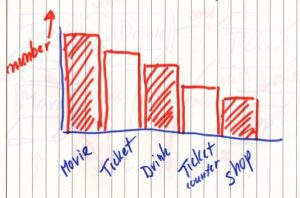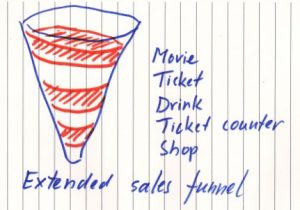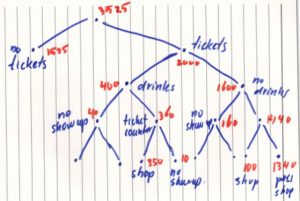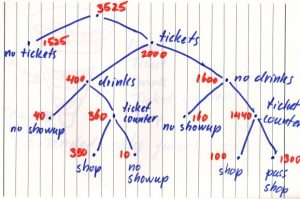“Why are you writing this Q & A?”
“Because people have questions, which are unanswered about ‘Bits of performance testing’ . ”
“Like?”
“The use of drawings and perfornance test it self.”
“So I can send in questions?””
“Sure on this page. Why not?”
“Hey, I am the one who is supposed to ask questions.”
Plan
“You used a lot of pictures. Is this not a waste of time?”
“In my blog post I drew a picture about the customer journey. This led to the conclusion that the Wifi network should be split in a private and public ones. This is not a waste of time.”
“I agree. But there were other pictures, which did not have that big impact.”
“That is right. But the drawing of picture takes minutes. Implementing the wrong performance scripts takes days.”
“You used SFDIPOT instead of another heuristic., FIBLOTS”
I am aware that this heuristic exists. I also know that a performance tester made it. And I just forgot it.
The reason I chose to pick SFDIPOT is to use this heuristic in another context. I learn by taking small detours. What if I do it in another way? My main reason was that I wanted to write about performance test in another way.
This kept my spirit high and extended my Circle of Comfort. That is a comfortable thought.”
“Your story about the performance test is sometimes difficult to follow. Why did you write a nonlinear story?”
“Testing is an activity which is unpredictable. I can find bugs on the strangest moments. This can trigger other ideas.
In this blog post I tried to describe what is going on in my head.”
“How can you sell this to your boss?”
“Just ask her or him, whether business cases are also written in a linear way?”
“I miss disk storage That is an important resource to watch.”
“You are right. I missed that one.”
“How do you know that this is a good load profile?”
“Some data have to be gathered. Think about log files and analytic stuff. The challenge is not to confuse frequency with resource usage.”
“Would you please explain that?”
“If 1000 users look to a simple web page, then almost no resources are used. If 1 user asks all articles in stock, then a lot will happen. The database is bring queried and much data is moved over the network. So look for resource usage.”
“So I only have to focus on user actions with heavy resource usage?”
“That is only possible with a very simple web site. Sometimes web sites or programs on the backend do not remove their garbage.”
“What do you mean with garbage?”
“Suppose you have a cinema web site. The purchasing department wants to know what kind of drinks and snacks are ordered in advance. Suppose all the results of the queries are stored. It might be interesting for their department and it should be stored on one of their systems. But not in a module of the web site.
Another thing is to simulate the customer. Use the customer journey. A customer does not only buys cards, snacks and drinks. She or he will also collect them. This lead to click paths, how does the user maneuver through the system: which screens will be visited and which options are used?”
“So if you have a lot of data, what do you do?”
“The challenge is to find patterns. Joe Common is more like this:”
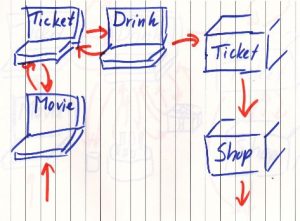
“Why did you not draw the payment page?”
“It is important. I left it out because of the page size. My plan was to sketch out a rough journey. Just wait a few pics.”
“I suppose you left out snacks out for the same reason. Smart ”
“Cheers”
“Why does he go one screen back?”
“That is hard to say. You can make some assumptions or hypotheses: the price was too high. Or the wrong movie was selected. You can always ask some questions to validate the assumptions.”
“Hey there is no deal. What’s wrong?”
“Most of the yearly cinema visitor is looking around or scouting. Were there any changes in the web site? Which movies can I see? ”

“What is going on here?”
“A children birthday party.”
“That looks like a lot of fun.”
“What are you showing me?”
“This is the number of screens and locations which were visited, and their corresponding numbers.”
“The bars in the graph are getting lower. Is this not frustating for marketing? ”
“Actually this is normal. This is a sales funnel.”
*It is like commercials: not everyone buys what they see on the television. They do not buy everything they see in the shop. You actually want people to do things which bring profit. The Call To Action or CTA for this web site is buy tickets, drinks, and snacks.”
“Okay Mr. Monologue. I’ve got a few questions.
How did you make that funnel?*
*Like this.*
*Why do you call this an extended sales funnel? Your CTA is buying tickets, drinks and snacks.*
*But there are two moments to buy drinks and snacks: in advance and on location.*
“If I had put the CTA in the first funnel picture, it would be cut off right under. By delaying this action I got a better view on the situation.
The second CTA is successful, if the first CTA.is good. John Common is not willing to buy extra drinks and snacks after a slow performance of the web site.”
*Are you writing that models can confuse people?*
*Yes, they do. Let me give another example.*
*Be my writer.*
*if you go twice to a cinema, you go twice through the sales funnel.

*So you should take repeat customers in account. *
For some businesses good customer contact is vital. In ‘Delivering Happiness: A Path to Profits, Passion, and Purpose’ it is called creating a moment of Wow.”
“And if things go wrong?”
“Just watch social media. Several companies have web care teams who actively look on the internet and engage with grumpy customers.”
“I would be interested in the numbers. So how would it look like?”
“Wait. This concept looks better than the draft one.”
“Are these estimated numbers for all visitors?”
“That is a good question. It is only for the website visitors, who also ordered drinks or snacks in advance. So I have to add a another set of numbers for the website visitors, who did not order drinks or snacks in advance and the visitors who pass the web site.”
“What is no showup?”
“That is a situation, when a customer does not get, what she or he paid for. He or she is ill. She or he found another group of friends and skipped the cinema.”
“This is strange: there are people who go to the shop without the ticket.”
“This is a common group mistake. A group of people at the cinema asking each other: “Who bought the tickets?””
“Why did you show the draft version?”
“I do not jump to solutions. I want to share my way of thinking. My thoughts and my pictures.”
“But those reversed trees with numbers is not a good starting point for scripting, I assume.”
“You are completely right. All that number crunching can take the attention away. If we have 3525 visitors coming in, then this must be translated in scripts somehow. We have to look at the chances.”
“But this is a cinema web site. It is not a casino.”
“Just have a look.”
“What does 70 % at Movie mean?”
“This means, that there is a chance of 70 % that a visitor goes from the Select Movie Window to Select Ticket Movie. You can call them of parts of click paths.”
“You are basically stating that the software has to roll a dice to determine the next step.”
“Yes. There is no single ideal path through the system. I already showed pictures of customer journeys.”
“Wait a sec.”
“Waiting.”
“The web site can easily be tested using a standard performance test, but a shop with real people is difficult. Do we need to test them? ”
“What is the system under test?”
“The web site and the shop.”
“Can you explain it to me?”
“The software supporting the web site and the shop are connected.”
“What does hold you back?”
“How can you test it?”
“I have not much experience with this particular situation. My suggestions would be: make a special interface for the shop just for performance test, mock the users in the shop, or use actual human beings. The latter option I call hybrid testing.”
“”Do you have experience with hybrid testing?”
“Yes, I have. For a web site we had to do a performance test. The visitors were simulated by the software. The web masters were real people including your interviewee. The actions of the web masters were too complicated to script, so we did testing manually. For more info there is a Dutch presentation, A performance test with a tail.”
“What is a good way to determine whether the performance is good enough?”
“A lot of people want a fixed number like a certain response time. Like the application will respond within 6 seconds. I’ve got an example.
In a performance test percentile is used: at least 90 % of the users have a response time of 6 seconds or less, if they do a specific action. This reduces discussions like:
“40 % has a response time of 5.3 seconds. That is quite good.”
“50 percentile has a response time of 6 seconds and the limit is 80 percentile.
Another thing to consider is to determine the worst realistic conditions for the system under test.”
Preparation
“Can automated tests be used with performance tests?”
“I assume you are talking about automated functional tests.”
“Yes.”
“I once got this request and it does not solve the problem. Is your manager writing a business case, a roadmap, and items for the back log for the same release at the same moment? I guess not. Every artefact has his own purpose.
But I wrote a blog post about the combination of automated tests and performance test.”
“When can the scripting start?”
“It is good to have a testable version before the final one.”
“But performance issues might still be in there. Also the interface can still change.”
“Change is always a companion of a tester. What I mean is that a tester should focus on things which will not change on long term. The technical basic components will probably not change. Test data is always needed. Data about the usage of the system is quite stable. Etc. ”
“There are always discussions about the test environment:
“We just put a part of the database in the test environment. “”
“Yes, a copy of the production environment is very expensive.
And yes, a performance test on a reduced environment can give a false impression.
I have a blog post about a huge test environment: Do you really need it?”
Execution or performance
“What would you advise during a performance test?”
“Have a hot line. If things go out of control, make sure everyone knows who to call or mail. Or your favourite communication style.”
Report
“So what should a test report contain?”
“In the report it should be described whether the performance criteria have been met. Percentile graphs are really cool. It is all about a special point in the graph:”
“I would like to see some real life graphs.”
“Sure be my guest. They are on slides 14 and 15 of the presentation, A performance test with a tail .”
“What about the resources?”
“That is a good question. This should be covered. A nice pic would be great, but that is something for another time.”
“Thanks for answering.”
“Thanks for questioning. And thanks for reading.”

